
Thelymitra crinita, commonly known as the blue lady orchid, the queen orchid, the lily orchid, is a species of orchid which is endemic to the south-west of Western Australia. It has a single broad, oval leaf and up to fifteen brilliant blue flowers with a blue column with the lobe on top of the anther covered with short, finger-like calli.

Thelymitra macrophylla, commonly called the large-leafed sun orchid or scented sun orchid, is a species of flowering plant in the orchid family Orchidaceae, and is endemic to the south-west of Western Australia. It has a single thick, broad, leathery leaf and up to twenty five relatively large dark blue to purplish flowers with white, toothbrush-like tufts.

Thelymitra ixioides, known as the spotted sun orchid or dotted sun orchid, is a species of orchid that is native to southern and eastern Australia and to New Zealand. It has a single long, thin, dark green leaf and up to ten flowers which occur in a range of colours, most commonly blue to purple but usually with small, dark blue spots. It is a variable species, similar to T. juncifolia which has smaller flowers.
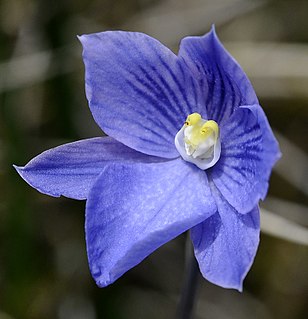
Thelymitra cyanea, commonly known as the veined sun orchid in Australia and as the swamp sun orchid or striped sun orchid in New Zealand, is a species of orchid which is native to New Zealand and south-eastern Australia. It has a single erect, fleshy, channelled leaf and up to five bright blue flowers with darker blue veins. It is usually found growing in swamps, sphagnum bogs, and subalpine herbfields, often in clonal colonies.

Thelymitra aristata, commonly called the great sun orchid, is a species of orchid that is endemic to south-eastern Australia. It has a single large, thick leaf and bracts and up to forty crowded blue or purplish flowers with darker veins.
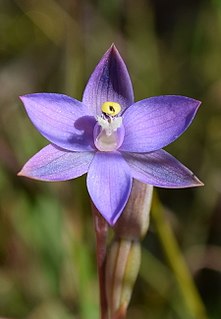
Thelymitra arenaria, commonly called the forest sun orchid, is a species of orchid that is endemic to south-eastern Australia. It has a single long, narrow leaf and up to sixteen purplish self-pollinating flowers which only open on hot days.
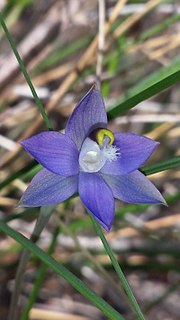
Thelymitra brevifolia, commonly called the peppertop sun orchid or short-leaf sun orchid, is a species of orchid that is endemic to south-eastern Australia. It has a single erect, relatively short and broad, dark green leaf and up to twenty purplish or purplish blue flowers. It is a common and widespread self-pollinating species occurring in a wide range of habitats.
Thelymitra exigua, commonly called the short sun orchid, is a species of orchid that is endemic to south-eastern Australia. It has a single fleshy, channelled, dark green leaf and up to eight relatively small pale blue flowers with white toothbrush-like tufts on top of the anther.

Thelymitra graminea, commonly called the shy sun orchid, is a species of orchid in the family Orchidaceae and is endemic to the south-west of Western Australia. It has a single leathery, channelled leaf and up to ten relatively small blue, self-pollinating flowers with white, toothbrush-like tufts on the top of the anther.

Thelymitra granitora, commonly called the coastal granite sun orchid or coastal sun orchid, is a species of orchid in the family Orchidaceae and is endemic to the south-west of Western Australia. It has a single short, curved and channelled dark green leaf and up to eight relatively large pale blue or white, self-pollinating flowers with white mop-like tufts on the top of the anther.
Thelymitra xanthotricha, commonly called the yellow tufted sun orchid or yellow tufted slender sun orchid, is a species of orchid in the family Orchidaceae and endemic to the south-west of Western Australia. It has a single erect, fleshy, channelled, dark green leaf and up to six relatively large dark blue to purplish flowers.
Thelymitra lucida, commonly called the glistening sun orchid, is a species of orchid that is endemic to south eastern Australia. It has a single erect, fleshy leaf and up to seven dark blue flowers with the sepals a lighter blue than the petals.

Thelymitra epipactoides, commonly called the metallic sun orchid, is a species of orchid that is endemic to south-eastern continental Australia. It has a single relatively large, leathery leaf and up to twenty large flowers that range in colour from pink to reddish but have a distinctive arrangement of lobes above the anther.
Thelymitra hiemalis, commonly called the winter sun orchid, is a species of orchid that is endemic to Victoria. It is a winter flowering orchid with greenish sepals and blue or mauve petals with large, irregular, darker spots.
Thelymitra polychroma, commonly called the rainbow sun orchid, is a species of orchid that is endemic to Tasmania. It has a single narrow, fleshy leaf and up to four blue and mauve flowers with darker veins. It grows in windswept heath and swampy areas and the flowers are self-pollinated.
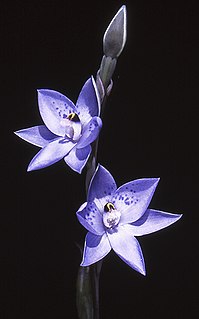
Thelymitra simulata, commonly called the collared sun orchid, is a species of orchid that is endemic to south-eastern Australia. It has a single fleshy, channelled leaf and up to six blue flowers with small darker spots. It grows in higher altitudes places part and the flowers have a purple lobe with a yellow tip on top of the anther.
Thelymitra sparsa, commonly called the wispy sun orchid, is a species of orchid that is endemic to Tasmania. It has a single erect, fleshy leaf and up to six relatively small blue flowers with a few small darker spots. The flowers are self-pollinated and open only slowly on hot days. The species is restricted to a few restricted montane sites in south-eastern Tasmania.
Thelymitra media, commonly called the tall sun orchid, is a species of orchid that is endemic to eastern Australia. It has a single fleshy, channelled leaf and up to thirty blue flowers with darker streaks but without spots. The labellum is narrower than the other petals and sepals.
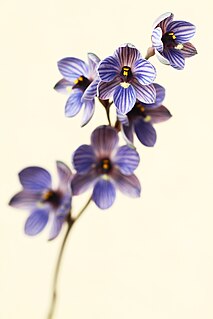
Thelymitra campanulata, commonly called the bell sun orchid or shirt orchid, is a species of orchid in the family Orchidaceae and is endemic to the south-west of Western Australia. It is a common species with a single narrow leaf and up to fifteen distinctly cup-shaped, prominently striped blue or mauve flowers with crowded, finger-like glands on top of the anther.
Thelymitra incurva, commonly called the coastal striped sun orchid, is a species of orchid that is endemic to south-eastern Australia. It has a single erect, dark green grass-like leaf and up to seven relatively large, pale blue flowers lacking the darker veins of some other thelymitras, especially the otherwise similar striped sun orchid. It grows in coastal areas of far south-eastern New South Wales and north-eastern Victoria.













